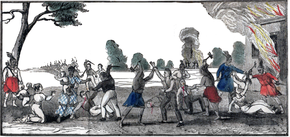William Cooley | |
|---|---|
 New River Massacre | |
| Born | 1783 State of Maryland |
| Died | 1863 (aged 79–80) |
| Occupation(s) | Justice of the Peace, politician, farmer, merchant, soldier |
| Known for | Florida pioneer |
| Political party | Democratic |
| Spouse | Nancy Dayton (c. 1805–1836) |
| Children | Almonock Cooley (c. 1827–1836) Montezuma Cooley (c. 1835–1836) unnamed daughter (c. 1825–1836) |
| Signature | |
William Cooley (1783–1863) was one of the first American settlers, and a regional leader, in what is now known as Broward County in the state of Florida. His family was killed by Seminoles in 1836, during the Second Seminole War. The attack, known as the "New River Massacre", caused immediate abandonment of the area by whites.[1]
Cooley was born in Maryland, but little else is known about his life prior to 1813, when he arrived in East Florida, a province of Spanish Florida, as part of a military expedition. He established himself as a farmer in the northern part of the province before moving south, where he traded with local Indians and continued to farm. During the period in which the region was transferred from Spanish to U.S. governance, he sided with natives in a land dispute against a merchant who had received a large grant from the King of Spain and was evicting the Indians from their lands. Unhappy with the actions of the Spanish, he moved to the New River area in 1826 to get as far as possible from the Spanish influence.[1]
In New River, Cooley sustained himself as a salvager and farmer, cultivating and milling arrowroot. His fortune and influence grew: he became the first lawman and judge in the settlement, besides being a land appraiser. Local Indians held him responsible for what they saw as a misjudgment involving the murder of one of their chiefs, and attacked the settlement in revenge on January 4, 1836.[1]
Cooley survived the attack and lived for a further twenty-seven years. He held administrative positions in Dade County,[2] moved to Tampa in 1837, and had a short stint working for the U.S. Army as a guide and courier.[3] He moved to the Homosassa River area in 1840, where he became the first postmaster and was a Hernando County candidate for the Florida House of Representatives. Returning to Tampa in 1847, he was one of the first city councilors, serving three terms[4] before he died in 1863.[2][3][4]
- ^ a b c Cooper Kirk (March 1976). "William Cooley: A Broward Legend" (PDF). Broward Legacy. 1 (1). Broward County Historical Commission. Retrieved June 22, 2007.
- ^ a b Cooper Kirk (March 1976). "William Cooley: A Broward Legend Part Two" (PDF). Broward Legacy. 1 (2). Broward County Historical Commission. Archived from the original (PDF) on April 13, 2020. Retrieved June 22, 2007.
- ^ a b Joe Knetsch (March 1989). "William Cooley explores the Everglades". Broward Legacy. 12 (2). Broward County Historical Commission. Archived from the original (PDF) on January 9, 2020. Retrieved June 22, 2007.
- ^ a b "Archives, Tampa City Council Members February 1856 – June 1904". Archived from the original on September 30, 2007. Retrieved June 22, 2007.